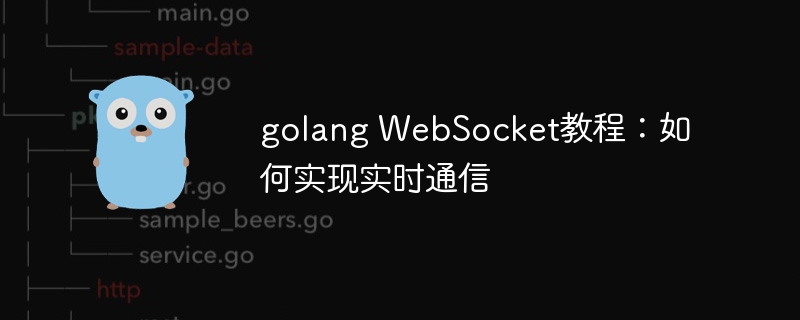

Golang WebSocket Tutorial: How to achieve real-time communication
First, let us introduce what WebSocket is. WebSocket is a protocol for full-duplex communication between a web browser and a server. Unlike the HTTP protocol, WebSocket allows the server to push data to the client and can implement real-time communication, event-driven and other functions.
In this tutorial, we will use Golang to implement a simple WebSocket server. We'll demonstrate how to establish a WebSocket connection, send and receive messages, and illustrate with concrete code examples.
First, we need to import Golang's WebSocket package:
import (
"log"
"net/http"
"github.com/gorilla/websocket"
)Then, we need to define a WebSocket upgrader (upgrader) to upgrade the HTTP protocol to the WebSocket protocol:
var upgrader = websocket.Upgrader{
ReadBufferSize: 1024,
WriteBufferSize: 1024,
CheckOrigin: func(r *http.Request) bool { return true },
}Next, we need to define a function that handles WebSocket connections. This function will be registered as an HTTP handler and will be called every time there is a WebSocket connection request:
func handleWebSocket(w http.ResponseWriter, r *http.Request) {
// 将HTTP连接升级为WebSocket连接
conn, err := upgrader.Upgrade(w, r, nil)
if err != nil {
log.Println(err)
return
}
// 在新的goroutine中处理WebSocket连接
go handleWebSocketConnection(conn)
}In the function that handles the WebSocket connection, we need to define a loop to handle receiving and sending messages:
func handleWebSocketConnection(conn *websocket.Conn) {
for {
// 读取客户端发送的消息
_, msg, err := conn.ReadMessage()
if err != nil {
log.Println(err)
return
}
// 打印接收到的消息
log.Println("Received message:", string(msg))
// 发送消息给客户端
err = conn.WriteMessage(websocket.TextMessage, []byte("Hello, client!"))
if err != nil {
log.Println(err)
return
}
}
}Now, we only need to register the above function as an HTTP processor and start an HTTP server:
func main() {
// 注册WebSocket处理器
http.HandleFunc("/ws", handleWebSocket)
// 启动HTTP服务器
log.Println("WebSocket server started on localhost:8080")
err := http.ListenAndServe(":8080", nil)
if err != nil {
log.Fatal(err)
}
}At this point, we have completed a simple WebSocket server. When a client connects to the server through WebSocket, the server will receive the message sent by the client and reply with a fixed message.
To test the server, we can use a browser plug-in, such as "Simple WebSocket Client", enter the server address ws://localhost:8080/ws and connect. Enter the message in the plug-in's message box and send it. We will be able to see the received message in the terminal and reply a message to the client at the same time.
The above is our basic tutorial on using Golang to implement WebSocket. WebSocket has great potential in real-time communication, event-driven, etc., and can be used in chat applications, real-time data visualization and other scenarios. Through this tutorial, I hope it can provide some help for you to understand and use WebSocket.
The above is the detailed content of golang WebSocket Tutorial: How to achieve real-time communication. For more information, please follow other related articles on the PHP Chinese website!




